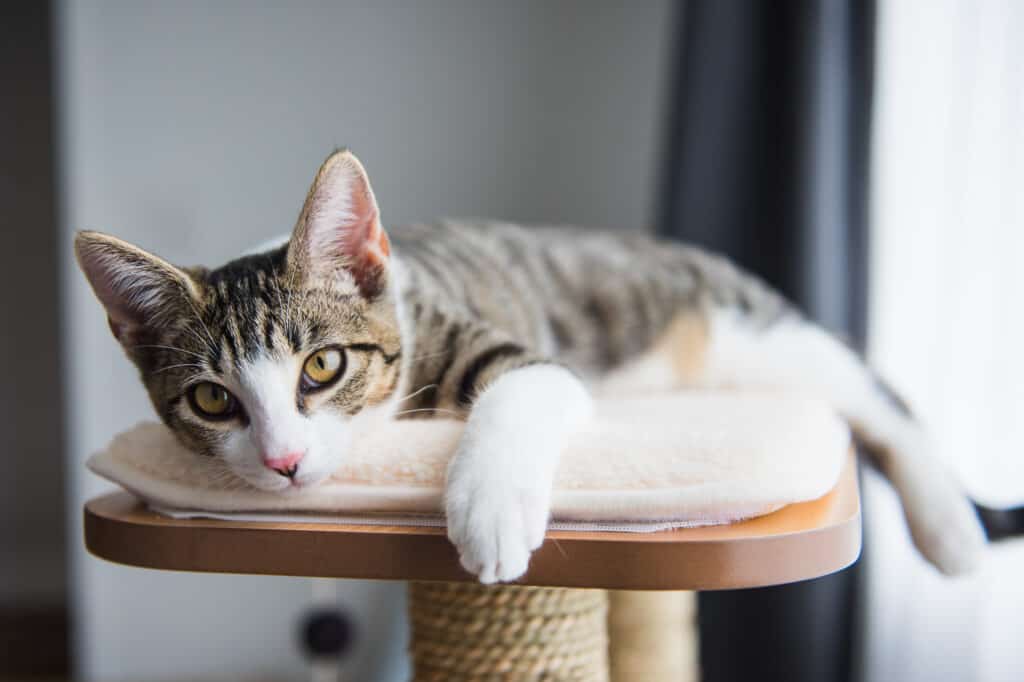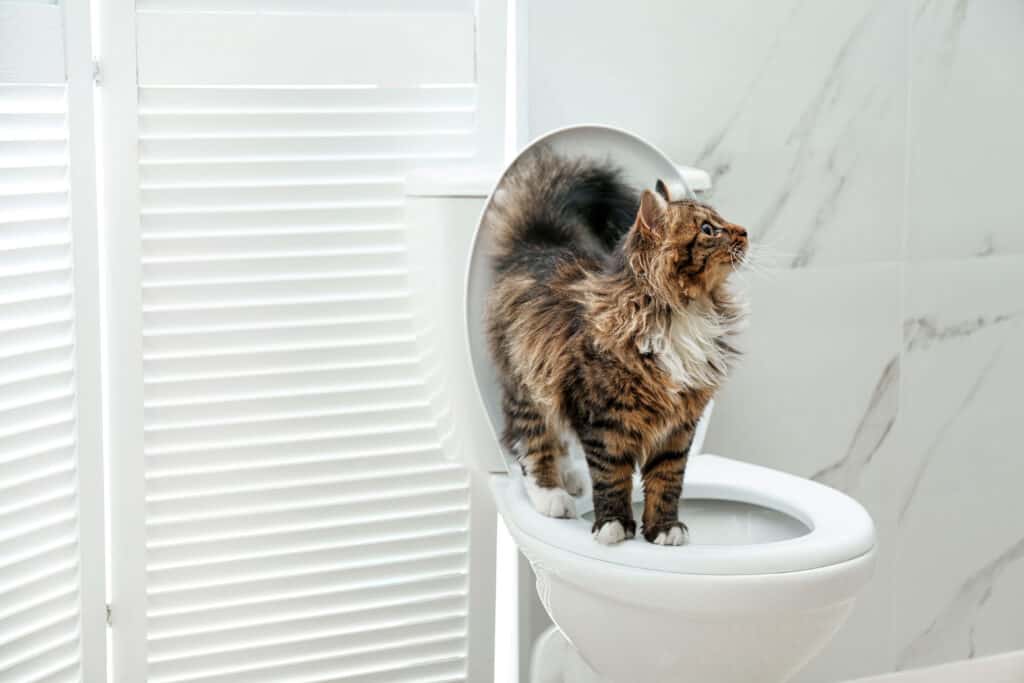The ultimate dream for a cat owner is to never have to empty the litter box and finally see their cats use the toilet. This dream is not impossible! Having your cats go straight to the bathroom when they need to relieve themselves is entirely plausible. You just need two things: patience and perseverance. Oh, and you need two bathrooms, too, so you do not have to share the bathroom while your cat is training. That will eliminate the need for you to clean up after them to use the toilet yourself. Here’s how to potty train your cat to use the toilet.
Define the Tasks
Once you are committed to potty training your cat, it’s time to understand a few things. Your cat already knows how to relieve itself—whether they are doing it outside or in a litter box—they just need to be trained to do it in a different place, like the toilet.
You do need a lot of patience and treats while you are training your cats. You have to reward them when they reach milestones, to encourage the process.
It is also important to understand that doing this will not be a walk in the park. It will take time, and there is no definite timeline for when they will learn how to use the toilet.
This is why you and everyone in the household should commit to this project. If you live alone, you’re on your own in trying to train your cats. But if you are with family, you must ask them to commit to teaching your cats, too, since they’ll be using the same bathroom.
Should Cat Parents Be Concerned About Their Pets’ “Natural Bathroom Behavior?”
Some cat parents are understandably concerned that potty training the cats will interfere with their pets’ natural bathroom behavior of covering their poop. The cats won’t have access to a bathroom all the time. Sometimes, they’ll go with their owners some place, where going to an actual bathroom will not be possible. Parents are concerned that they may lose their instinct of covering their poop when they relieve themselves outdoors.
There is nothing to worry about. It is an instinct for cats to cover what they leave behind. And even if they sometimes forget, the convenience of not having to empty a litter box at home is well worth the trouble of cleaning up after your cats in the few times you’ll be outdoors with them.

Training your cat to use the toilet is possible with this guide!
©Anna Hoychuk/Shutterstock.com
When Is a Cat Ready for Toilet Training?
A cat or kitten is ready for toilet training once they know how to use the litter box.
If you have a kitten with you, wait until they are four weeks old and have learned to use the litter box. With an adult cat, you can begin the training immediately.
Once your cats can use the litter box, that’s a sign they can be toilet-trained. There’s a good chance your cats will never learn how to flush a toilet or put down the seat. You should be okay with them simply learning how to use the toilet. That alone is a cause for celebration.
Step 1: Prepare the Designated Bathroom
Choose a bathroom in your house that your cat has the easiest access to. Then, move the cat’s litter box inside the bathroom, preferably near the toilet. At first, your cat will go to where the litter box used to be. Point at them to enter the bathroom, where they’ll find their litter box in the new, designated place.
Eventually, they will get used to going to the bathroom to relieve themselves in their litter box. This is when you know your cat is ready for the next step.
Step 2: Get the Supplies
Your cats need to transition from the litter box to a training seat. There are many kitty training seats on the market. You can get one for around $30 to $50. A cat training seat is placed over the toilet bowl, similar to a training seat for kids.
As the cat progresses in training, the owner needs to cut bigger holes in the center of the training seat so the cat can get used to relieving themselves directly into the toilet. Some kits come with removable holes, so you don’t need to do the cutting yourself.
Making Your Own Training Tray
If you want to save money, you can create a training seat for your cat. It will be called a training tray since it won’t have an indentation like the one in commercial cat training seats.
To make a training tray, you need an aluminum roasting pan bigger than the size of your toilet, about 12 5/8″ x 10 1/8″ x 3″. You would also need duct tape and plastic wrap.
The process of using the training tray is simple. All you need to do is place the aluminum tray over the toilet’s rim. Ensure it will not fall into the toilet by securing it with duct tape. If there are gaps between the toilet’s edge and the aluminum tray, fill those with plastic wrap.
Step 3: Raise the Litter Box
Once you have a training seat, you can raise the litter box in increments of three inches each day until it is level with the toilet seat. The goal is to make your cats comfortable enough to jump onto the toilet seat level when they have to relieve themselves. You can use stacks of cardboard, newspaper, and magazines to raise the litter.
Step 4: Put the Litter Box on Top of the Toilet
Once the litter box is on the same level as the toilet seat, put it on top of the training tray. If you have a commercial-grade training kit, all you need to do is put the seat on your toilet’s rim since there’s flushable litter in the indentation. Leave the tray or seat there for a few days. Make sure your cat becomes comfortable on it.
Step 5: Remove the Litter Box
If you see that your cat is comfortable on top of the litter box, it’s time to remove it and let the cats use the tray or training seat.
For the training seat, use the smallest pan with no hole. Fill the pan with flushable litter.
If you are going to use the aluminum tray, fill it with biodegradable litter. For now, there’s no need to cut holes in the tray.
Step 6: Begin the Transition
Watch your cats closely because they will tell you when they are ready to transition to using the toilet. When there are no more “accidents” in using the litter box on top of the toilet seat, they can transition into bigger training seats with bigger holes.
For the training tray, use a screwdriver to cut the holes in the bottom. Make the holes slightly bigger every day.
This is also when you can decrease the amount of litter you put in the pan or the seat. Every day, lessen the litter until your cats get used to relieving themselves there with almost no litter at all.
Step 7: Remove the Training Seat
You need about two weeks (sometimes more) before you can remove the training seat altogether. The best thing to do is monitor your cat’s progress.
As the owner, you will know if they are comfortable enough not to have the seat or tray anymore.

Potty training your cat takes time, but it is worth it!
©New Africa/Shutterstock.com
Advantages of Having Toilet-trained Cats
While toilet-training your cats takes time, the rewards are endless. You no longer have to worry about cleaning your cat’s litter box, because their waste just gets flushed down the toilet!
Saves Costs of Buying Litter
How much are litter boxes and the refill of litter? You could be spending between $100 to $300 a year on litter. You can save this amount by teaching your cats how to use the toilet. The more cats you have, the more litter you need each year.
Eliminates the Smell of Litter Boxes From Your Home
Litter has an unpleasant smell. Even if you place it outside, the odor sometimes seeps inside your house. Without litter in the house, you can keep it smelling fresh and clean, always!
Seeing Your Cats Become Independent
Is there anything more satisfying than seeing your cats become truly independent? Cats are independent by nature, but they will be more so once they begin using the toilet. They won’t have to rely on their owners to freshen up their litter boxes.
Conclusion
There will be a lot of challenges while you are toilet-training your cats. It is all part of the journey to ensure you never have to buy and get rid of cat litter again. Be patient enough to wait for them to learn. Give them treats when they deserve it. Be generous with your compliments. And lastly, celebrate every milestone, even if it takes a while. It will all be worth it in the end!
Next Up…
- The Best Cat Litter for Picky Cats (and Kittens!): If your cats are particular about their litter, here are the top picks by our experts that will help.
- All Of Your Cat’s Crazy Behaviors, Explained: Cats can act in weird and mysterious ways. Here are some of their behavior explained.
- The Best Cat Food for Indoor Cats: Reviewed and Ranked: Cats need a lot of pampering and here are the best cat food you can buy reviewed by our experts.
The photo featured at the top of this post is © Anna Hoychuk/Shutterstock.com
Thank you for reading! Have some feedback for us? Contact the AZ Animals editorial team.






